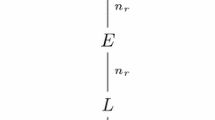Abstract
In this paper, we demonstrate a new and original way to apply the representation theory of finite groups to the development of space–time codes for use in multiple antenna wireless communications. We include a summary of the relevant mathematical model for wireless communications on a multiple-antenna environment. We apply our construction in two examples and demonstrate that they outperform other designs in the literature.
Similar content being viewed by others
References
Alamouti SM (1998) A simple transmit diversity technique for wireless communications. IEEE J Sel Area Comm 16:1451–1458
Biglieri E, Elia M (1976) Cyclic-group codes for the Gaussian channel. IEEE Trans Info Theory 22:624–629
Blake IF (1972) Distance properties of group codes for the Gaussian channel. SIAM J Appl Math 23:312–324
El Gamal H, Damen MO (2003) universal space-time coding. IEEE Trans Info Theory 49(5):1097–1119
The GAP Group (2006) GAP—Groups, Algorithms, and Programming, Version 4.4 (http://www.gap-system.org)
Hassibi B, Hochwald B (2002) Cayley differential unitary space-time codes. IEEE Trans Info Theory 48(6):1438–1503
Hochwald BM, Mazetta TL (2000) Unitary space-time modulation for multiple-antenna communication in Rayleigh flat-fading. IEEE Trans Info Theory 46:543–564
Hochwald BM, Sweldens W (2000) Differential unitary space-time modulation. IEEE Trans Info Theory 48:2041–2052
Hughes BL (2000) Differential space-time modulation. IEEE Trans Info Theory 46:2567–2578
Humphreys JE (1990) Reflection groups and Coxeter groups. Cambridge Studies in Advanced Mathematics, Vol.29. Cambridge University Press, Cambridge, . xii+204pp
Mittelhozer T, Lathtonen J (1996) Group codes generated by finite reflection groups. IEEE Trans Info Theory 42:519–528
Niyomsataya T, Miri A, Nevins M (2004) Unitary space-time codes from group codes: permutation code variant II. In: Proceedings of the IEEE Canadian conference electrical and computer engineering, CCECE 2004, Niagara Falls, Canada, Vol. 1, pp 597–600
Niyomsataya T, Miri A, Nevins M (2004) On the construction of space-time Hamiltonian constellations from group codes. In: Proceedings of the IEEE international conference on communications, ICC 2004, Paris, France, vol. 1, pp 613–617
Niyomsataya T, Miri A, Nevins M (2004) Improving the diversity product of space-time constellation designs. In: Proceedings of the IEEE international symposium on information theory, ISIT 2004, Chicago, USA, pp 186
Niyomsataya T, Miri A, Nevins M (2005) Unitary space-time constellations based on finite reflection group codes. In: Proceedings of the canadian workshop in information theory, CWIT 2005, Montreal, Canada, pp 264–267
Niyomsataya T, Miri A, Nevins M. On an application of the Bruhat decomposition to the design of full diversity unitary space-time codes, submitted
Oggier F, Lequeu E, (2005) Families of unitary matrices achieving full diversity. In: Proceedings of IEEE international symposium on information theory, 2005 (ISIT 2005), Adelaide, Australia, pp 1173–1177
Oggier F, Rekaya G, Belfiore J-C, Viterbo E (2006) Perfect space time block codes. IEEE Trans Info Theory 52(9): 3885–3902
Sethuraman BA, Sundar Rajan B, Shashidhar V (2003) Full-diversity, high-rate space-time block codes from division algebras. IEEE Trans Info Theory 49(10):2596–2616
Shokrollahi A, Hassibi B, Hochwald BM, Sweldens W (2001) Representation theory for high rate multiple-antenna code designs. IEEE Trans Info Theory 47:2335–2367
Slepian D (1968) Group codes for the Gaussian channel. Bell Sys Tech J 47:575–602
Tarokh V, Jafarkhani H, Calderbank AR (1999) Space-time block codes from orthogonal designs. IEEE Trans Info Theory 45:1456–1174
Warner FW (1983) Foundations of differentiable manifolds and Lie groups Corrected reprint of the 1971 edition. Graduate Texts in Mathematics, 94. Springer-Verlag, New York Berlin
Author information
Authors and Affiliations
Corresponding author
Additional information
Communicated by D. Jungnickel.
Rights and permissions
About this article
Cite this article
Miri, A., Nevins, M. & Niyomsataya, T. Applications of representation theory to wireless communications. Des Codes Crypt 41, 307–318 (2006). https://doi.org/10.1007/s10623-006-9023-8
Received:
Revised:
Accepted:
Published:
Issue Date:
DOI: https://doi.org/10.1007/s10623-006-9023-8
Keywords
- Unitary space–time codes
- Representation theory
- Finite groups
- Diversity product
- Reflection groups
- Wireless Communications
- Hamiltonians
- Group codes




